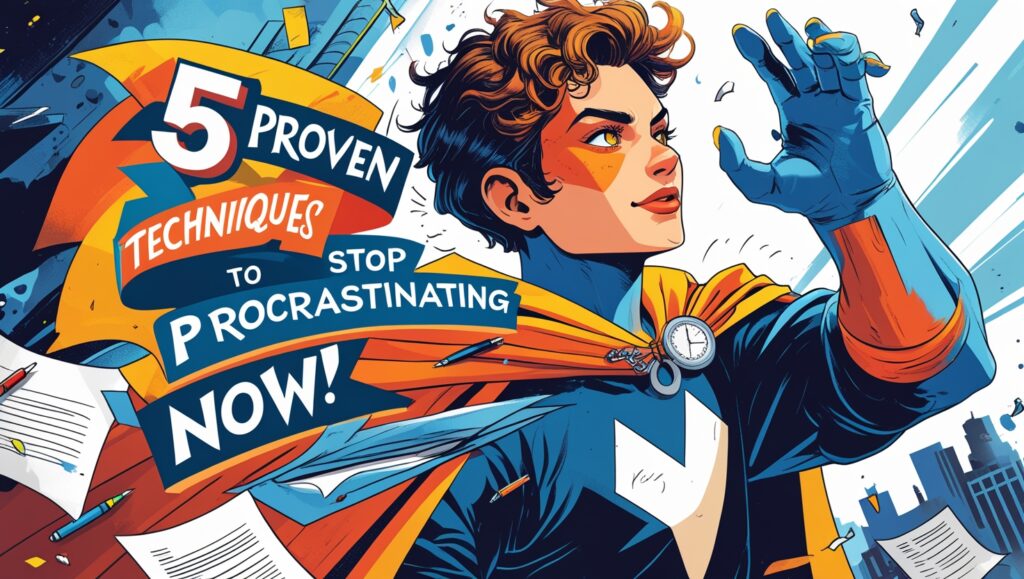You know what you need to do. You’ve planned, made lists, even promised yourself that today would be different. But instead of making progress, you scroll through your phone, tidy up your desk, or binge a series. Sound familiar?
Procrastination is a silent thief of time. It doesn’t just delay your progress—it builds anxiety, lowers confidence, and increases the pressure for tomorrow. The longer you wait, the harder it becomes to start.
The good news? You can break this cycle today. Below are five practical, science-backed strategies you can use immediately to stop procrastinating and take action.
1. The 5-Second Rule: Trick Your Brain Into Movement
This powerful mental tool, popularized by Mel Robbins, is designed to help you bypass hesitation. The moment you hesitate, your brain starts generating excuses. The 5-Second Rule cuts off this internal dialogue before it can sabotage your intentions.
How it works: When you feel yourself stalling, count down in your head: 5-4-3-2-1. As soon as you reach one, take action. Stand up. Open the document. Put on your running shoes. Whatever small step you can take—do it.
Why it works: This technique interrupts negative thought patterns and activates the prefrontal cortex, the part of the brain responsible for decision-making and goal-oriented behavior.
Real-life examples:
- You’re putting off replying to an email. Count down and start typing.
- You’ve been meaning to exercise. Count down and grab your gym gear.
- You need to make a difficult phone call. Count down and dial the number.
This rule is especially useful when the hardest part is getting started—because once you begin, the resistance often disappears.
2. The 2-Minute Rule: Lower the Barrier to Entry
When a task feels too big, your brain naturally wants to avoid it. The 2-Minute Rule helps you overcome this resistance by making tasks feel so small, they’re impossible to ignore.
How it works: If a task seems overwhelming, reduce it to an action that can be completed in two minutes or less. Then do it. Often, once you’ve started, you’ll naturally keep going.
Why it works: Starting is the hardest part. Once you’re in motion, inertia takes over. The 2-Minute Rule creates a quick win that builds confidence and momentum.
Here’s a table of common tasks and their 2-minute versions:
| Big Task | 2-Minute Version |
|---|---|
| Write a 10-page report | Write one sentence |
| Clean the house | Wipe the kitchen counter |
| Read a book | Read the first paragraph |
| Study for an exam | Review one flashcard or page |
| Meditate for 20 minutes | Close your eyes and breathe for 2 min |
Try this: Pick a big task you’ve been avoiding. Now shrink it. Just do the smallest possible version. Then, if you feel like continuing—great. If not, at least you’ve made progress.
3. Time Blocking: Schedule the Work You Avoid
Procrastination often creeps in when there’s no clear plan. Time blocking creates structure by assigning specific blocks of time to important tasks.
How it works:
- Choose a task you’ve been putting off.
- Schedule it into your calendar just like a meeting or appointment.
- When the time comes, do only that task—no multitasking.
Why it works: Time blocking reduces decision fatigue. You don’t waste energy wondering what to do or when to do it—it’s already decided. It also increases commitment. When something is scheduled, you’re more likely to take it seriously.
Example schedule:
| Task | Time Block |
|---|---|
| Write article draft | 9:00 AM – 10:30 AM |
| Review exam notes | 2:00 PM – 3:00 PM |
| Answer emails | 4:00 PM – 4:30 PM |
| Deep focus session | 10:30 AM – 12:00 PM |
Treat your scheduled blocks with respect. Don’t push them aside. And be sure to leave breaks between sessions to prevent fatigue.
Pro tip: Start with your most avoided task first thing in the day. This builds momentum and reduces stress.
4. Temptation Bundling: Make Work Rewarding
One reason procrastination happens is that your brain craves instant gratification. If a task feels boring, unpleasant, or repetitive, your brain would rather do anything else. That’s where temptation bundling comes in.
How it works: Pair a task you avoid with something you enjoy. You’re not bribing yourself—you’re making the task more appealing by attaching a reward to it.
Why it works: This strategy builds positive associations with tasks that normally feel like a chore. It makes starting less painful and the process more enjoyable.
Examples:
| Task to Avoid | Reward to Bundle With |
|---|---|
| Doing cardio | Listen to your favorite podcast |
| Folding laundry | Watch an episode of your favorite show |
| Studying | Sip your favorite tea or coffee |
| Cleaning the kitchen | Play upbeat music |
It’s simple, effective, and can turn even the dullest chore into a more positive experience.
Try this: Think of one task you’ve been delaying. Now think of something you love. Combine them—and begin.
5. Never Skip Twice: Build Consistency, Not Perfection
No one is perfect. You’ll occasionally miss a workout, skip a study session, or delay writing. The key is not letting one missed day turn into two—or worse, a lost habit.
How it works: If you miss a habit once, accept it and move on. But make sure you don’t miss it twice in a row.
Why it works: This rule keeps small setbacks from snowballing into a return to procrastination. It reinforces your identity as someone who follows through—even when life gets in the way.
Examples:
- Missed a workout? Don’t miss the next one, even if it’s just a 10-minute walk.
- Skipped writing yesterday? Write a few sentences today.
- Didn’t review notes this morning? Read a page before bed.
It’s not about doing it perfectly every day—it’s about showing up consistently.
Final Thought: Procrastination Is a Pattern—You Can Break It
We often wait for motivation, but motivation doesn’t come first—action does. Once you start, your brain catches up. You begin to feel progress, and with that progress comes momentum.
Here’s a recap of the five techniques you can start using today:
- The 5-Second Rule: Override hesitation by counting down and acting immediately.
- The 2-Minute Rule: Make tasks feel small and easy to begin.
- Time Blocking: Schedule work into focused, distraction-free time slots.
- Temptation Bundling: Pair boring tasks with enjoyable activities.
- Never Skip Twice: Build consistency and bounce back quickly.
You don’t need to use all of them at once. Choose one. Apply it today—right now if possible. Because the best time to stop procrastinating isn’t tomorrow—it’s now.
Gabriel Silva is the founder of Cursos e Soluções, a blog dedicated to personal growth, habit change, and self-discipline. Passionate about self-development and productivity, he shares practical, research-backed strategies to help people achieve their goals. He believes that small, consistent changes can lead to significant transformations over time and is committed to providing content that empowers both personal and professional success.







